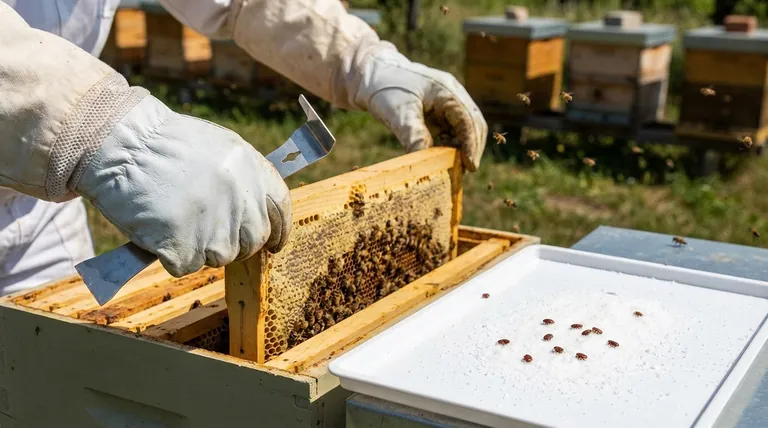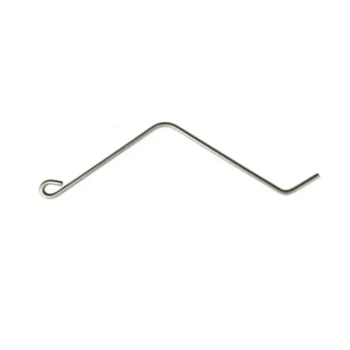The single most critical factor for hive survival in modern beekeeping is systematic mite monitoring. This practice provides precise, real-time data on the Varroa mite pressure within your colonies. This knowledge empowers you to make informed, timely decisions, applying control measures only when necessary to prevent infestation levels from reaching a critical threshold that leads to colony loss.
Treating for Varroa mites without monitoring is like taking medicine without a diagnosis. You risk either doing too little and losing the hive, or using treatments unnecessarily. Consistent monitoring transforms hive management from reactive guesswork into a proactive, data-driven strategy for colony health.

From Guesswork to Precision: The Goal of Monitoring
Quantifying an Invisible Threat
Varroa mites are deceptive. Their population grows exponentially within the capped brood, hidden from a beekeeper's daily inspections.
Monitoring techniques, like an alcohol wash or sugar roll, make this invisible threat visible. They provide a specific number—such as "mites per 100 bees"—that turns a vague concern into a measurable data point.
Enabling Proactive Intervention
Knowing your mite count allows you to act before the colony shows visible signs of stress. By the time you see symptoms like deformed wings, it's often too late.
Monitoring allows you to intervene when mite loads cross a set threshold, preventing the population from ever reaching a level that causes irreversible damage.
Preventing Colony Collapse
Unchecked Varroa populations weaken the bees' immune systems and transmit deadly viruses. This deadly combination is the primary driver of colony losses worldwide.
Regular monitoring is the first line of defense against this outcome, ensuring the colony remains strong and resilient.
The Seasonal Rhythm of Mite Infestation
Early Spring Baseline
A mite count in early spring establishes your starting point for the season. Low levels after winter are a good sign, but this is when the mite population begins its exponential growth alongside the bee population.
The Critical Late Summer Spike
Late summer is the most dangerous period for mite infestations. The bee population naturally begins to decline while the mite population, which has been breeding all season, reaches its peak.
This danger is compounded by limited treatment options while honey supers are on the hive and the high risk of re-infestation from nearby, collapsing colonies.
Pre-Winter Health Check
A final assessment in the fall is crucial. This check ensures that the "winter bees"—the long-lived generation that must survive until spring—are healthy and have a very low mite load. A high mite count heading into winter is a near-certain death sentence for the colony.
Understanding the Risks: The Cost of Inaction
The Danger of Re-infestation
A single, unmonitored hive that collapses from a high mite load becomes a "mite bomb" for the entire area.
As the colony fails, its bees attempt to enter healthier nearby hives, carrying vast numbers of mites with them. Your own diligent monitoring protects not only your hives but also those of neighboring beekeepers.
The Problem with a Fixed Schedule
Simply treating on a fixed calendar schedule is inefficient and often ineffective. Mite populations can spike unexpectedly due to environmental factors or re-infestation.
Only by monitoring can you know if your previous treatments worked and if a new intervention is required. It allows you to adapt your management to the reality inside the hive.
Making the Right Choice for Your Hives
Consistent monitoring is the foundation of a successful Varroa mite management plan. Your specific goals will determine your focus.
- If your primary focus is survival: Implement a strict schedule of monitoring at least three times a year—spring, mid-summer, and fall—to ensure you never cross infestation thresholds.
- If your primary focus is minimizing treatments: Monitoring is your most essential tool. It provides the data to justify intervention, allowing you to act only when absolutely necessary.
- If your primary focus is preventing apiary-wide problems: Consistent monitoring allows you to identify "hot spot" hives and address them before they can spread mites to your other colonies.
Ultimately, monitoring transforms you from a passive keeper into an informed and effective colony manager.
Summary Table:
| Monitoring Goal | Key Benefit | Recommended Timing |
|---|---|---|
| Colony Survival | Prevent mite loads from reaching critical thresholds | Spring, Mid-Summer, Fall |
| Minimize Treatments | Apply controls only when necessary, based on data | Before and after treatment cycles |
| Prevent Apiary Spread | Identify and isolate 'mite bomb' hives early | Consistent checks throughout season |
Protect Your Investment with the Right Tools
Systematic monitoring is the foundation of successful beekeeping, but it requires reliable equipment. HONESTBEE supplies durable, precise beekeeping supplies and equipment to commercial apiaries and beekeeping equipment distributors. Ensure your colonies thrive with tools designed for accuracy and efficiency.
Contact HONESTBEE today to discuss your wholesale equipment needs and build a stronger, more resilient operation.
Visual Guide

Related Products
- HONESTBEE Advanced Ergonomic Stainless Steel Hive Tool for Beekeeping
- Professional Dual-End Stainless Steel Hive Tool for Beekeeping
- Professional 3-Bar Frame Grip with Integrated Hive Tool
- Adjustable Formic and Acetic Acid Dispenser for Bee Mite Treatment
- Lightweight Durable Plastic Queen Excluder Scraper for Beekeeping
People Also Ask
- What are the basic tools for beekeeping? Essential Starter Kit for Safe & Successful Hive Management
- How should beekeepers handle bees when using a hive tool? Master Calm, Deliberate Techniques
- Why do hive tools have a hole? Unlock the Secret to Efficient Beekeeping
- What are the features of a regular hive tool? The Essential Multi-Tool for Every Beekeeper
- What is the hole in a hive tool for? A Multi-Tool for Apiary Repairs and Maintenance



















